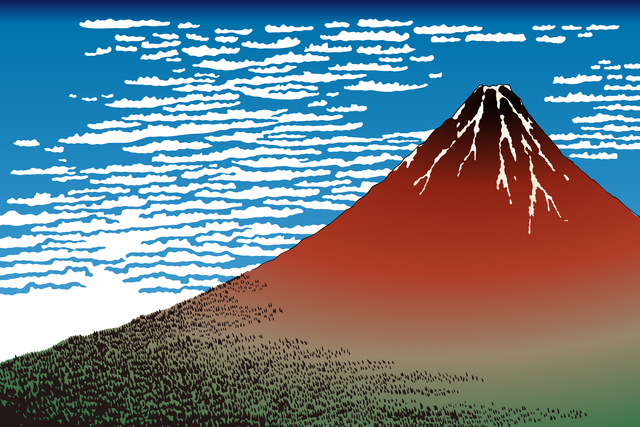This small shrine called Fuji Sengensha Shrine is the last religious structure you will see on Trail 1 in the course of heading for the peak of Mt. Takao.
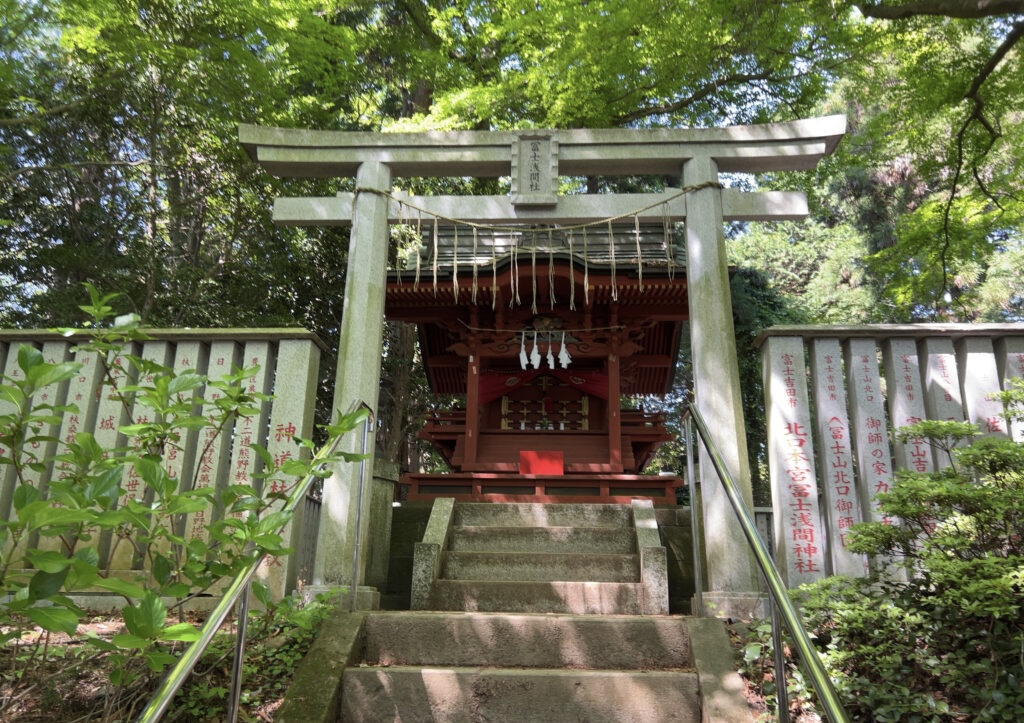
It is a branch shrine of Fujisan Hongu Sengen-taisha Shrine that has some 1,200 year history headquartered in Shizuoka prefecture.
“Fujisan” is a Japanese name of Mt. Fuji.
Fujisan Hogu Sengen-taisha Shrine is said to be dedicated to the female deity called Konohanasakuyahime no Mikoto who is known as a woman of great beauty and also the wife of Ninigi no Mikoto who is the grandson of Amaterasu, the ancestral goddess of the Japanese imperial family.
The head shrine is located at one of the most traditional starting points for climbing Mt. Fuji in the city of Fujinomiya in Shizuoka prefecture, which trailhead was more popular when Kyoto was the capital of Japan.
The existing head shrine buildings were built in 1604 by Tokugawa Ieyasu, the 1st shogun of Tokugawa shogunate.
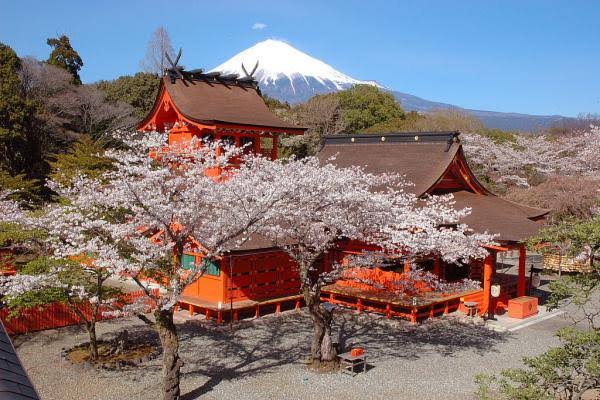
The divine object of worship in which the spirit of the female deity is supposed to reside is the entire top of Mt. Fuji from the 8th stage upwards, which is at the same time an integral part of the shrine precincts.
This religious truth was legally confirmed by the Supreme Court Decision dated 9 April 1974.
That is, after the World War II, under the new Constitution of Japan the freedom of religion is guaranteed and the principle of separation of religion and politics is also provided there.
Consequently, Shinto shrines and Buddhist temples lost their right to use the land owned by the Japanese government.
To remedy the situation, the Japanese government decided to transfer the land constituting the shrine or temple grounds, which had been nationalized since the Meiji Restoration, to the relevant Shinto shrines and Buddhist temples.
Having said that, the Japanese government transferred only the shrine grounds located at the foot of Mt. Fuji to Fujisan Hongu Sengen-taisha Shrine.
Eventually, the religious institution started the litigation against the Japanese government in 1957 claiming that the entire top of Mt. Fuji from the 8th stage upwards is the divine object of worship in which the spirit of the enshrined female deity is considered to reside and that it should consequently constitute an integral part of the shrine grounds, which was in fact once recognized and confirmed by Tokugawa Ieyasu.
This case has been decided against the Japanese government while the legal transfer of the land didn’t happen until 2004.
It’s mainly because the relevant local governments of Yamanashi prefecture and Shizuoka prefecture Mt. Fuji straddles haven’t reached an agreement as to the prefectural border on the entire top of Mt. Fuji from the 8th stage upwards.
As this situation still continues, no land registration has yet been done.
So, as of today, we don’t know which prefecture the peak of Mt. Fuji does belong to.
Fuji Sengensha Shrine in Mt. Takao, as one of the branch shrines of Fujisan Hongu Sengen-taisha Shrine, was established in the early 16th century by Hojo Ujiyasu the 3rd Generation Head of Hojo clan, one of the then most powerful feudal lords in the eastern Japan.
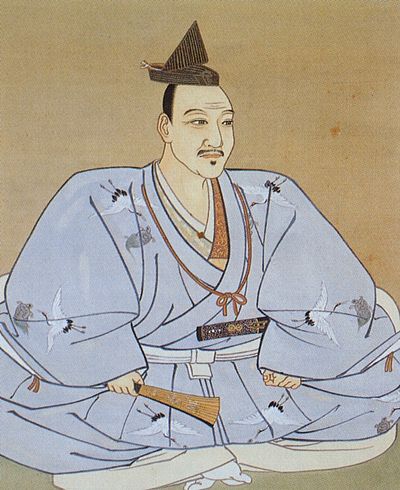
In the civil war period (from the late 15th century to the late 16th century), Hojo clan had from time to time territorial disputes and engaged in armed conflicts with other feudal lords in the neighboring states such as the present-day Yamanashi prefecture and the present-day Shizuoka prefecture where Mt. Fuji is located.
So, Hojo Ujiyasu kindly established this small shrine for the convenience of people of his domain who were eager to make pilgrimage to Mt. Fuji without running the risk of passing through the territory of the enemies.
As you may be aware, Fujisan Hongu Sengen-taisha Shrine including Okumiya shrine (a detached shrine) located at the top of Mt. Fuji forms a part of Fujisan, a sacred place and source of artistic inspiration, one of the UNESCO World Cultural Heritage Sites in Japan since 2013 (https://whc.unesco.org/en/list/1418/).
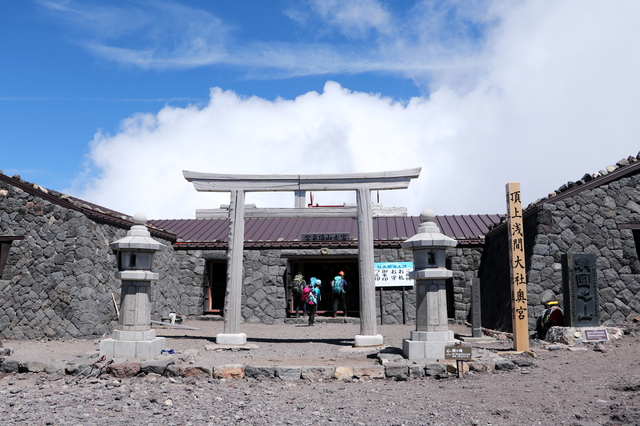
Mt. Fuji has been the subject of many paintings and poems.
Many of the Japanese artists and poets have been inspired by the majestic figure of Mt. Fuji.
Katsushika Hokusai (1760 – 1849), a Japanese ukiyo-e artist of the Edo period is one of them.
He is best known for the woodblock print series Thirty-Six Views of Mt. Fuji which is my favorite.
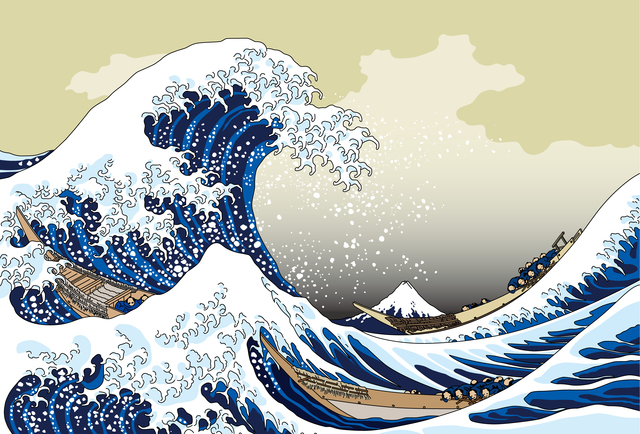
Miho-no-Matsubara, with over thirty-thousand pine trees growing on its 7km beach, has been registered as a part of Fujisan, a sacred place and source of artistic inspiration irrespective of its location, 45 kilometers away from Mt. Fuji.
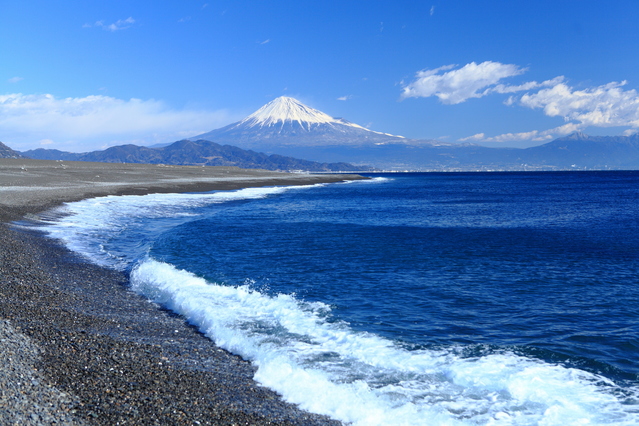
The green pine forest, the white waves, and the blue ocean, along with Mt. Fuji, has been expressed through various drawings such as ukiyo-e of Utagawa Hiroshige (1797 – 1858), as well as waka poems (traditional Japanese poems of thirty-one syllables).
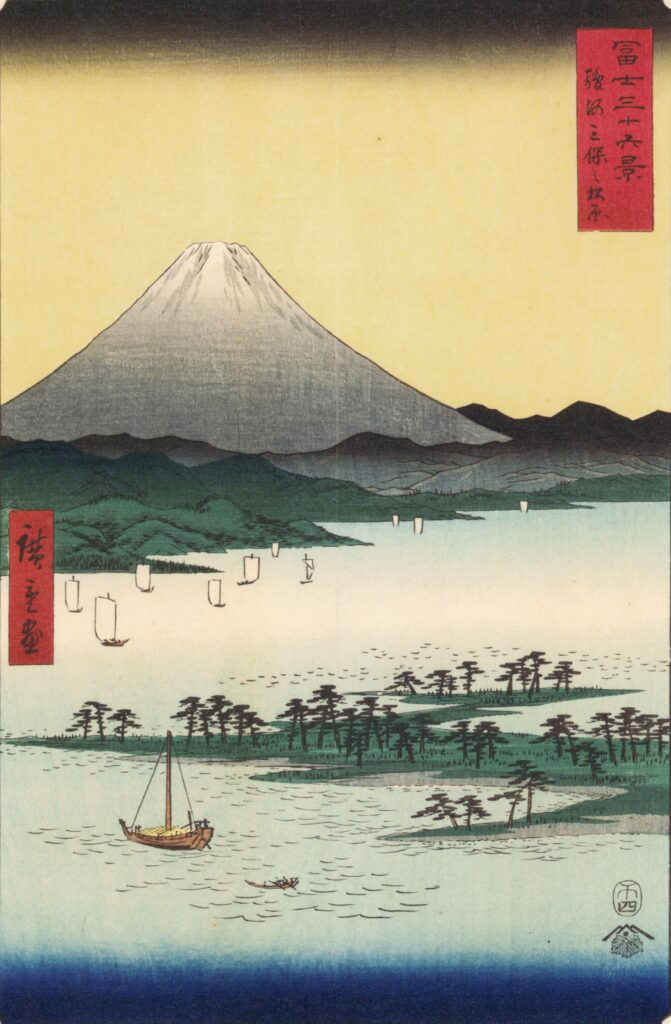
Unfortunately, Mt. Takao seems to be a little too far (52.2 kilometers away) from Mt. Fuji to be a part of the World Heritage Site.
In the Edo period, the act of making pilgrimage to Mt. Fuji for worship became more widely popular among commoners.
Having said that, until the late Edo period, no women were admitted to Mt. Fuji.
According to one theory, it was to avoid the jealousy of the female deity.
So, in the Edo period, a lot of women made pilgrimage to Fuji Sengensha Shrine in Mt. Takao which was a much easier alternative than climbing Mt. Fuji.
Therefore, a lot of men, in those days, made pilgrimage to this small shrine as well to hit on young (or older?) girls and otherwise, which contributed to the prosperity of Yakuo-in Temple.
As is the case with Mt. Fuji, a mountain god is generally regarded as female, resulting in a humble reference to a man’s wife.
I have been married with my mountain god for the past 36 years.
As time goes by my mountain god has gradually come to wear the pants in my family and my status there has experienced a gradual downward trend.
I’m afraid that I’m getting off track again.
Osamu Dazai, a notable Japanese novelist and author (1909 – 1948) said in his work to the effect that evening primroses, called “Tsukimisou” in Japanese, (blooming in the healthy beauty) is well in harmony with the landscape with (the majestic figure of) Mt Fuji.
Like Hokusai, Hiroshige and Dazai, being also inspired by Mt. Fuji, I would say “Mt. Takao is well in harmony with the landscape with Mt. Fuji”.
On a clear, sunny day, you should have a good chance to see Mt. Fuji from the peak of Mt. Takao.
Thus, you can worship Mt. Fuji far away from the peak of Mt. Takao.
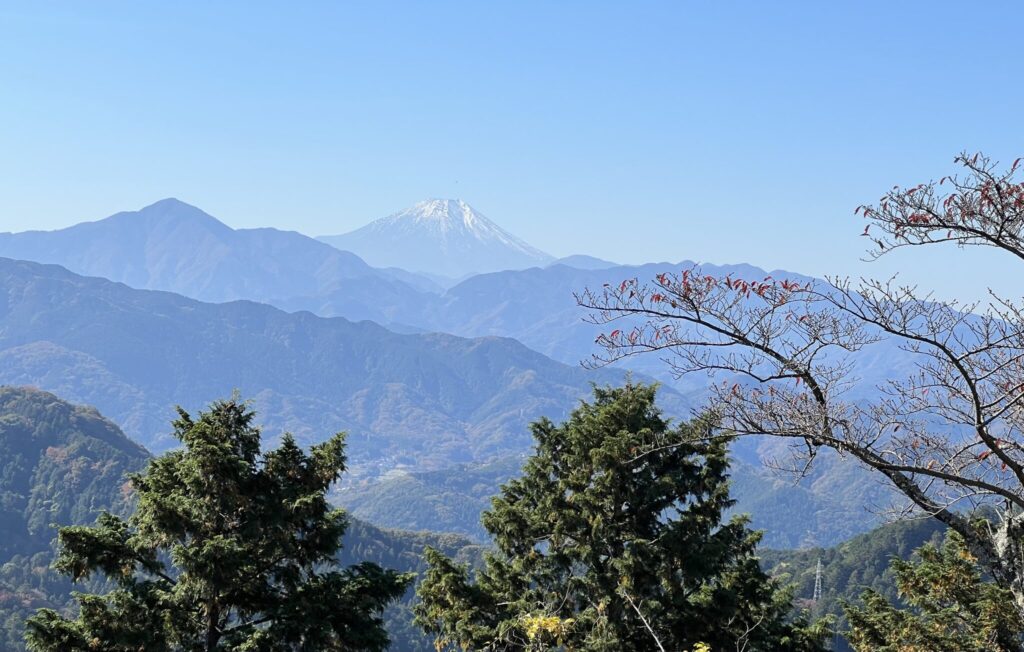
Last but not least, I would like to point it out that the peak of Mt. Takao is one of the most famous observation spots of the Diamond Fuji Phenomenon.
The Diamond Fuji Phenomenon refers to the optical phenomenon that the sun sparkles like a jewel above Mt. Fuji during the sunset or sunrise.
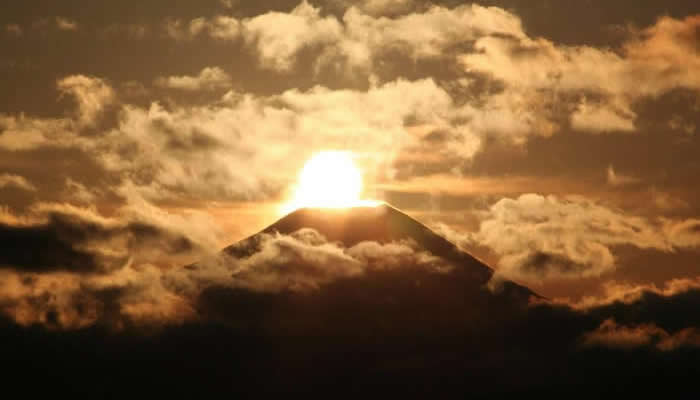
In theory, depending on the location, the Diamond Fuji Phenomenon can be observed from a certain point twice a year between the summer solstice and the winter solstice in the geographical areas indicated below.
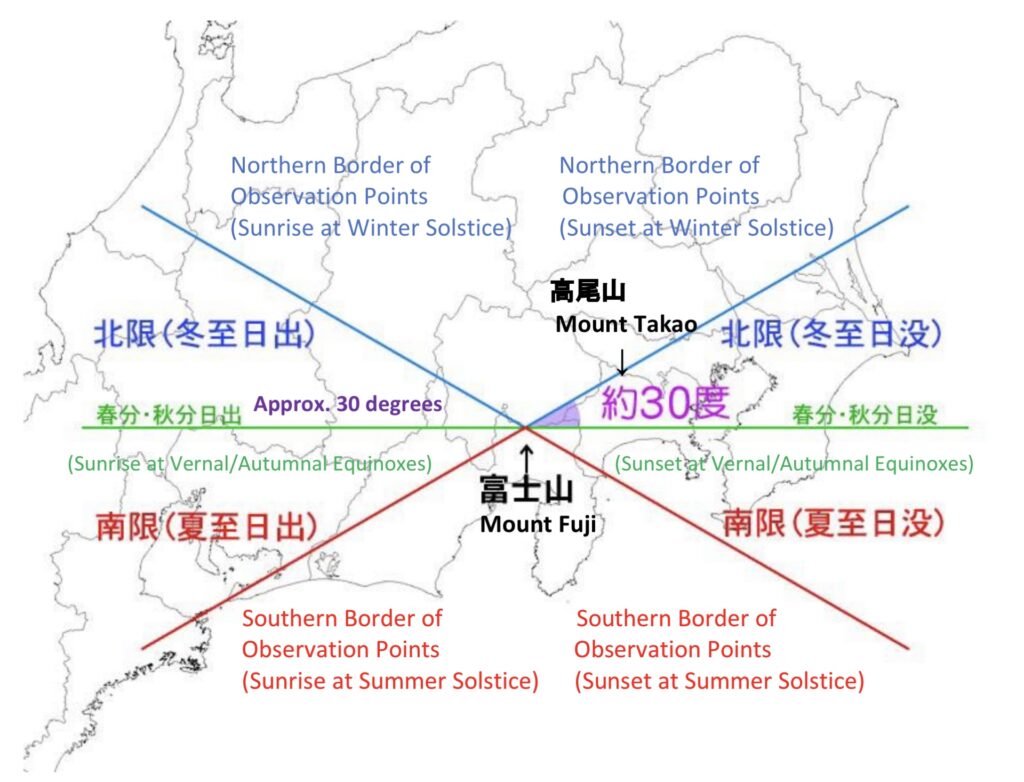
Mt. Takao is located on the northern border of the eastern range of the area where we can observe the Diamond Fuji Phenomenon.
So, the opportunity to see the Diamond Fuji Phenomenon from Mt. Takao is limited to just once a year.
In theory, you would have a good chance to witness this mysterious and awe-inspiring phenomenon from the peak of Mt. Takao during the sunset around the winter solstice when we have the shortest day and the longest night of the year in the Northern Hemisphere.
I hear that on that day the peak of Mt. Takao is as crowded as Shinjuku Station that holds the Guinness World Record for being the world’s busiest train station.
Surely, this overstates the situation but it is true that the Japanese have felt a deep affinity with Mt. Fuji since ancient times.
